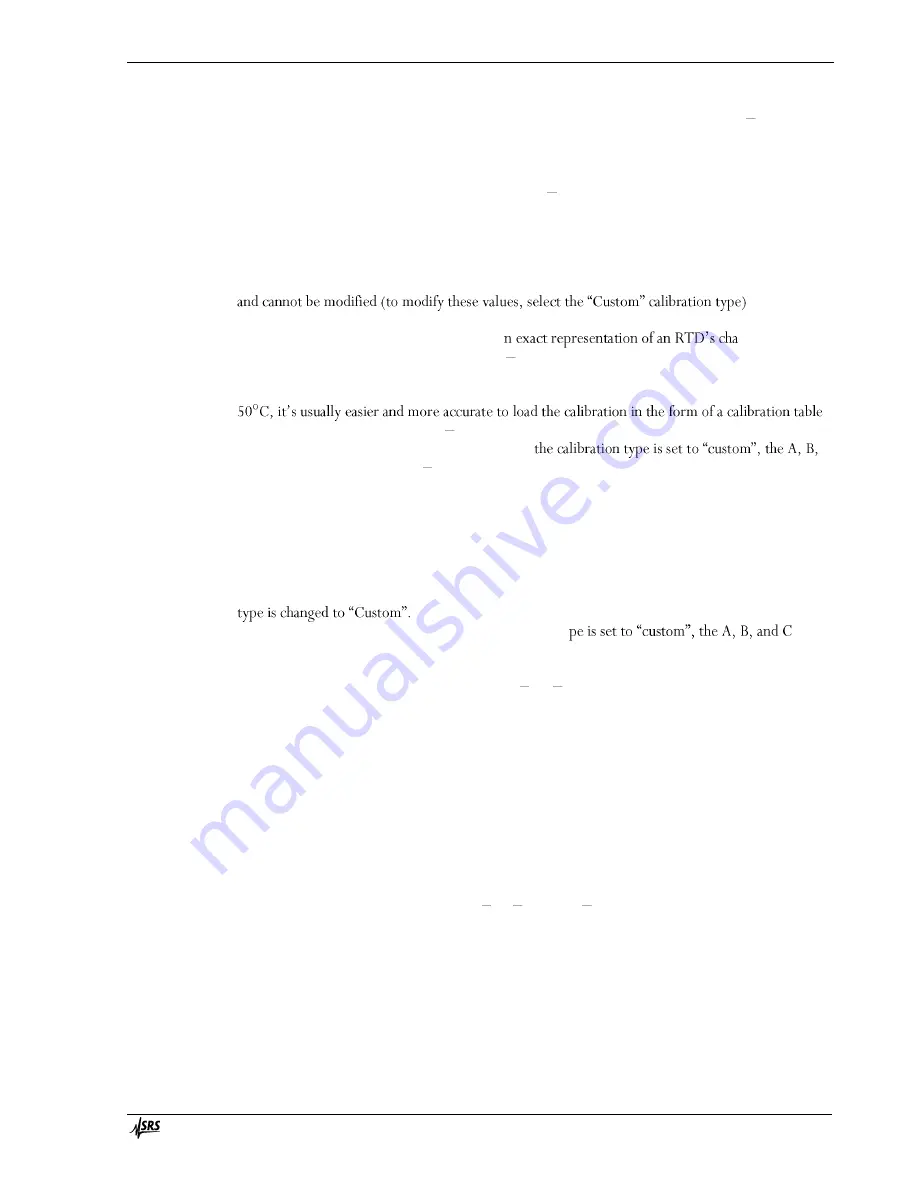
Operation
65
CTC100 Programmable Temperature Controller
RTDs: If the sensor is an RTD, A, B, C, and R0 are the constants for the Callendar van Dusen
equation. The temperature t is calculated from the RTD resistance R
t
based on the following
equation:
R
t
= R
0
(1 + At + Bt² + (t
100)Ct³) below 0°C
R
t
= R
0
(1 + At + Bt²) above 0°C
R
0
is the resistance of the RTD at 0°C, expressed in ohms; t is the temperature in °C.
When the calibration type is set to IEC751 or US, the A, B, and C settings are automatically
changed to the values for that particular calibration, and the A, B, and C controls are greyed out
. The value of
R0, however, is not preset and can still be modified.
The Callendar-van Dusen equation is not a
racteristics, but
is accurate to about 50 mK in the range -200 400°C. In contrast, class A commercial RTDs that
have not been individually calibrated are accurate to 150 mK at 0°C and 950 mK at 400°C.
If you are calibrating your own sensor and the calibration points are separated by less than about
instead of calculating the Callendar van Dusen coefficients.
Thermistors: If the sensor is a thermistor and
and C settings are the Steinhart Hart coefficients. The temperature T (expressed in K) is calculated
from the thermistor resistance R (in ohms) based on the following equation:
T = (A + B·ln(R) + C·ln³(R))
-1
If a standard thermistor calibration is selected, the A, B, and C controls are automatically
changed to show the best-fit coefficients for whichever curve is selected. These figures are
approximations only and are not actually used to calculate the temperature unless the calibration
Diodes: If the sensor is a diode and the calibration ty
settings are a polynomial fit to the diode calibration curve:
T = A BV CV²
where T is the temperature in Kelvins and V is the voltage across the diode in volts. Note that
polynomial fits are only accurate within a limited temperature range.
If a standard diode calibration is selected, the A, B, and C controls show best-fit coefficients for
whichever curve is selected. These figures are approximations only and may not produce the same
results as the standard calibration curve.
A standard diode or bipolar junction transistor can be connected to the CTC100 and used as a
low-cost temperature sensor. In this case a custom calibration must be used. If the voltage across
the diode is measured at two known temperatures, the calibration coefficients can be calculated as
follows:
B = (T
1
T
2
) / (V
1
V
2
)
A = T
1
+ (V
1
· B) + 273.15
C = 0
where V
1
is the voltage (expressed in volts) at temperature T
1
(expressed in °C), and V
2
is the
voltage at temperature T
2
. The resulting calibration is a linear approximation. For greater accuracy,
a custom calibration table should be used instead of the A, B, C coefficients; see page 24.
Содержание CTC100
Страница 1: ...Version 2 1 May 14 2019 User Manual CTC100 Cryogenic Temperature Controller...
Страница 6: ......
Страница 8: ......
Страница 12: ......
Страница 25: ...Operation 13 CTC100 Programmable Temperature Controller...
Страница 85: ...Operation 73 CTC100 Programmable Temperature Controller To disable cascade cont select it...
Страница 128: ......
Страница 129: ...Remote Programming 117 CTC100 Programmable Temperature Controller...
Страница 130: ......
Страница 142: ......
Страница 150: ......
Страница 176: ......
















































